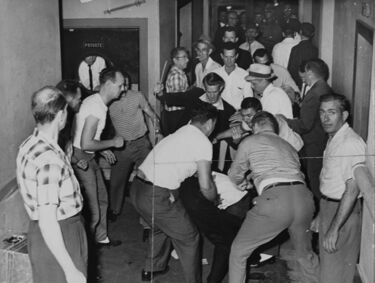Trailways Bus Depot
The Trailways Bus Station or Birmingham Trailways Station was a bus station serving interstate buses operated by the Continental Trailways association and Missala Stages. It was located at 1900 4th Avenue North, on the northwest corner of the intersection with 19th Street North, the present site of a Wells Fargo drive-thru ATM.
The station building had previously served as a grocery store. The entrance faced 4th Avenue while buses pulled into a 50' x 150' lot extending to the alley behind the building from 19th Street. A 12-foot deep shed roof protected passengers waiting outside. Buses departed from the station by continuing through 4th Alley North to 20th Street. Inside the station was a Union News Co. restaurant and a Travel Bureau tourist agency office. The station had segregated waiting areas with a total of 42 seats. P. G. Sutter was the station's manager in the early 1960s.
The station was the site of a brutal attack by white supremacists against participants in the Freedom Rides on May 14, 1961. A group armed with chains, pipes and clubs met riders as they entered the station from the rear, injuring several of the demonstrators, both white and black. Birmingham Police officers arrived fifteen minutes after the first blows were struck, breaking up the fracas with no immediate arrests. The riders found themselves stranded in Birmingham as no members of the Amalgamated Association of Street and Electric Railway Employees Local No. 1314 were willing to continue the trip to Montgomery and thence to New Orleans. The demonstrators continued their journey by air.
A photograph of the attack made by the Birmingham Post-Herald's Tom Langston was published around the world. Attendees at a Rotary International conference in Tokyo, Japan confronted Birmingham delegate Sidney Smyer with the shocking image of brutality, convincing him to work to eliminate such injustices as they would increasingly damage the city economically.
Later the same year, in August 1961, Public Safety Commissioner Bull Conner and traffic engineer Ben Robinson found that the station facilities were inadequate for the 1,000-plus passengers using the station each day. The arrangement of the bus loading area and the lack of a designated zone for parcel deliveries to the building combined to tie up traffic on adjacent streets. Connor instructed city attorney J. M. Breckinridge on September 5 to "inform these people" (the station's owners), that "their place is entirely too small for their operation at this location." The bus company stated to city officials that it was seeking to move the station to a larger facility. The station was still in use, however, for at least three more years.
References
- Robinson, Ben F. (August 31, 1961) Letter to Commissioner Eugene Connor. Birmingham Public Library Digital Collections
- Conner, Eugene "Bull" (September 5, 1961) Letter to J. M. Breckinridge, City Attorney. Birmingham Public Library Digital Collections
- Fazio, Michael W. (2010) Landscape of Transformations: Architecture and Birmingham, Alabama. Knoxville, Tennessee: University of Tennessee Press ISBN 9781572336872
